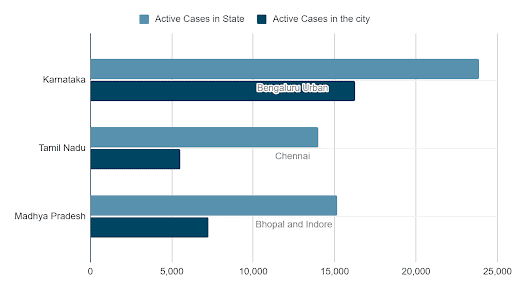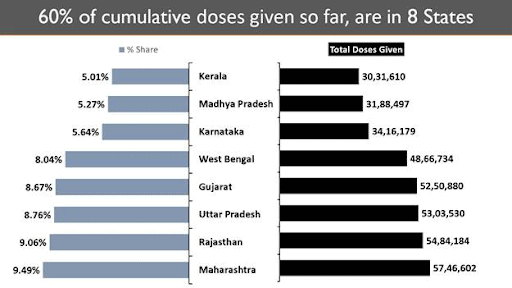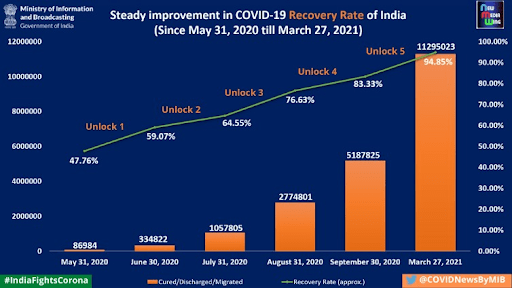25th March 2021 marked one year of the COVID-19 lockdown that was imposed by the Government of India in order to curb the countrywide spread. Prime Minister Narendra Modi in his address to the nation on 24th March 2020 emphasised the need to impose a nation-wide lockdown and ensure the wellbeing of the citizens.
From March last year to this, a lot has changed. India has made some rapid advancements in terms of COVID-19 preparations and is currently administering phase II of the COVID-19 vaccination programme. Additionally, the states have also re-opened industries, airports, workplaces, public transport, gyms, markets, malls etc. allowing businesses and society to return to normalcy. This is to ensure that the economy bounces back, quickly and strongly.
However, as I write this article, states and cities are facing a second, resurgent wave of COVID-19, leading to fears of local lockdowns and targeted restrictions once again. The Centre has described the COVID situation in the country as one that has gone from bad to worse since mid-February, and the chairman of the National Expert Committee on Vaccine Administration has said that the virus seems to spark up every time we begin to feel that we have controlled it.
The PM has advised all the CMs to adhere strictly to the “test-track-treat” mantra in order to contain the second wave of infection.
Last year on 25th March, India had 647 active cases and only a single death. On 26th March, 12:30 PM, India had 4.18 lakh active cases and 1.60 lakh people had lost their lives to COVID-19.
In this article, we revisit some of the key issues and events from last year’s lockdown, how the country is faring in its fight against the virus now, the vaccination program and the way ahead.
What did lockdown achieve?
This remains a tricky question to answer. There are clearly two schools of thought, one believing that it did give India some time to prepare and save crucial lives, whereas the other criticizes it for its hurried and unplanned implementation, creating a negative impact on the economy and giving birth to the migrant crisis.
Going by the numbers, however, the COVID-19 curve started declining from the second week of April – approximately after two weeks of lockdown – suggested Prof. Shamika Ravi, who had been tracking the crisis with her methodical data analysis each day since the outbreak. The government also shared that the rate of doubling of cases had risen to a high of 12 days compared to three days at the start of the lockdown on 25th March 2020. “We have flattened the curve,” claimed Lav Agarwal, Joint Secretary, Union Health Ministry in a press conference on 2nd May 2020.
Read more: The second wave of COVID: The how and the why
However, critics pointed out that the government was merely painting a positive picture and setting a narrative to show the superficial successes of the lockdown. The lockdown really didn’t slow the speed of spread much. The first 5000 cases took roughly three months, whereas the count reached 10,000 in only six days and 15000 in another four. Also, cases surged in several states like MP, Maharashtra, Punjab and others, even as the lockdown progressed through different phases, signalling that they were struggling to keep the spread in check.
How did India work on its testing infrastructure?
One of the views in favour of implementation of the lockdown holds that it ensured adequate time and preparation for testing, hospitalization and critical care. It took some time for the government to ramp up testing capabilities.
The testing numbers have reached an average of 10 lakh tests a day today from 60,000 in May 2020 (compared to a few thousands in early March 2020). Also in April last year, India was conducting less than 0.01 tests per 1000 people daily — the lowest amongst the South and Southeast Asian nations like Malaysia, Thailand, Taiwan, Nepal, Srilanka, Pakistan, Vietnam and Japan. Only Bangladesh, Indonesia and Myanmaar were testing less than India. In March 2021, India conducted the second most number of tests per 1000 population in the region, after Malaysia.
The testing strategy, however, has been questioned by several public health experts, according to whom it has failed to check the spread of infection. In 2020, the government adopted the strategy of testing only those with travel or contact history or those having symptoms. Despite signs of community transmission, the government refused to amend the testing strategy, allowing for a sharp rise in COVID-19 cases. The use of RAT tests and their unreliable outcome also attracted lots of criticism.
However, later on, the government expanded its testing drive by roping in private testing labs and widening the testing criteria. As of 26th March 2021, there exist 2428 COVID-19 testing labs in India out of which 1226 are govt while 1202 are private. Also, the government is equipped with 1394 RT-PCR testing labs. So far, India has tested close to 24 crore samples with an average of more than ten lakh tests in a day.
Check the complete list of ICMR approved testing centres as on 26th March 2021:
https://www.icmr.gov.in/pdf/covid/labs/archive/COVID_Testing_Labs_26032021.pdf
Did the pandemic affect the cities more?
It will not be wrong to say that the pandemic had an urban face and affected the urban population more than the rural. This was primarily because of two reasons: First, the high concentration of human population and economic activities in urban areas created more chances for the infection to spread. Second, containment measures like lockdown and restricted travelling prevented large scale spread to rural areas.
In the initial days, the pandemic was heavily concentrated in mega urban centres like Delhi, Mumbai, Chennai and Bengaluru before spreading to other non-metro cities like Ahmedabad, Nagpur, Nashik, Pune, Bhopal, Indore, Jaipur, Hyderabad, Bhubaneswar etc. Later on, these cities made the bulk of COVID-19 cases in the country. District administrations and city governments were mobilized to take charge of the situation and contain the spread.
Cities have shown another concerning trend — a high case fatality ratio (CFR). Sangli in Maharastra shows the highest CFR at 3.4% followed by Mumbai and Solapur at 3%. Ahmedabad in Gujarat is also having a CFR at 3.4%. Sagar in Madhya Pradesh continues to have a CFR at 2.6%.
| City | State | Case Fatality Ratio (CFR) |
| Sangli | Maharashtra | 3.4% |
| Ahmedabad | Gujarat | 3.3% |
| Mumbai | Maharashtra | 3% |
| Solapur | Maharashtra | 3% |
| Sagar | Madhya Pradesh | 2.5% |
Also, urban hubs continue to be the super spreader and highly infected. For example, 32% of the total active cases in Maharashtra as on March 27th were reported from Pune and Mumbai together. Similarly, 50% of the active caseload in MP is from the twin cities of Indore and Bhopal. 69% cases in Karnataka are from Bengaluru Urban whereas 39% cases in TN are from Chennai.

What’s the progress of India’s vaccination programme?
The one good thing that happened in 2021 was the start of India’s vaccination programme on 16th January 2021. Before this, the country’s apex drug regulator body – Central Drugs Standard Control Organisation (CDSCO) – granted emergency use approval to Covishield by Serum Institute of India and Covaxin by Bharat Biotech. As I write this piece, Bharat Biotech’s Covaxin has not completed the third stage of trials and data for the same is not out yet. However, the pharmaceutical giant has claimed the vaccine’s efficacy to be at 80% in its interim data analysis.
The government has set an ambitious target of vaccinating three crore healthcare and frontline workers. In the second phase, citizens with 60 plus age and those above 45 but with a comorbidity have been included in the plan. The government has now decided to expand the vaccination drive for everyone above 45 (with or without comorbidity) from 1st April 2021. So far, 5.5 cr doses of vaccination have been administered.
Read more: Struggling to book or reschedule a slot for the COVID vaccine? Read this
Maharashtra leads the share in national vaccination coverage with 9.42% followed by Rajasthan (9.11%) and Uttar Pradesh (9.05%). Ten states of Kerala, Madhya Pradesh, Karnataka, West Bengal, Gujarat, Uttar Pradesh, Rajasthan and Maharashtra account for 60% of the cumulative vaccination coverage across the country.

Experts have raised concerns with the Indian authorities over the slow rate of vaccination in the country. With the second wave of infection growing strong, the vaccination programme needs a boost and wider beneficiary base. These experts have also urged the government to look at the possibilities of roping in the private sector in the vaccination program. The government has decided to expand the base by allowing anyone above 45 (with or without comorbidity) to get vaccinated from 1st April 2021 onwards.
The government, however, has shown no signs of decentralizing the drive with the private sector yet. The Union Health Ministry has termed the drive as “Jan Bhagidari Andolan” (Citizen Participation Movement) and an example of how efficiently the federal system can work in administering the immunisation programme in times of crisis.
In a recent development, the Union Health Ministry has increased the timeline for the second dose of vaccination for the Covishield vaccine type from current 4 to 6 weeks to 6 to 8 weeks. The decision was taken on the basis of scientific recommendations made by the National Technical Advisory Group on Immunization (NTAGI) and National Expert Group on Vaccine Administration for COVID-19 (NEGVAC). Experts believe that increasing the time period will result in an enhanced efficiency of the vaccine.
As a result, now persons who have been vaccinated with Covishield for their first dose can get the second dose anytime between 6 to 8 weeks. No automatic appointment will be provided for the second dose. Beneficiaries will have to book an appointment on the COWIN system at the vaccination centre which is offering the same vaccine as was administered on your first dose. On spot appointment is also available, however prior online registration is advised to avoid long queue and waiting.
How are cities dealing with the second wave of COVID-19?
Meanwhile, the COVID-19 second wave has firmly gripped the country. Once again, many cities are entering the night and weekend lockdown mode. Madhya Pradesh has imposed night lockdown in Bhopal, Indore and four other districts. Night curfews have also been imposed in Ahmedabad, Vadodara, Surat and Rajkot in Gujarat and in Ajmer, Bhilwara, Jaipur, Jodhpur, Kota, Udaipur, Sagwada and Kushalgarh in Rajasthan.
The Maharashtra government has imposed a state-wide night curfew from March 28th onwards. Guardian minister Ajit Pawar has indicated the possibility of a complete lockdown in Pune, if the situation remains alarming. Pune has more than 52,000 active cases and an active case ratio at a whopping 10.4%. Complete lockdown has already been imposed in districts of Parbhini and Nanded in Maharashtra.
Amidst a sudden surge in Chhattisgarh, several district administrations of the state have introduced a new set of measures to curb the spread. The Raipur district administration has banned the entry of people at tourist spots and prohibited any kind of social, religious or political programmes. Seven days of home quarantine have also been mandated by the district administration for people returning to the city either from air, rail or road.
Nagpur in Maharashtra is also struggling against the virus. More than 20,000 active cases have been added to the district’s tally over the last two weeks. The district’s active rate is pegged at an alarming 20%. Recovery rate also remains slow for the district at 74% compared to the national’s 94%. Districts of Aurangabad and Nashik are also showing extremely high active case rates at 26% and 15% respectively.
Chandigarh administration has designated 25 areas as containment zones. The administration has made sanitization of these areas compulsory and are focussing on strictly implementing the COVID-appropriate behaviour.
Amidst the sudden surge in cases, Ludhiana in Punjab has decided to launch a door to door vaccination drive from April 1st. A mobile team of four people will go door to door to vaccinate people above 45 years of age (with or without co-morbidities). To start with, the team will start visiting the large residential colonies and industrial units having more than 2000 employees.
Maharashtra continues to be critical with more than 62% of the country’s total caseload with sudden surge being observed in MP, Chhattisgarh and Punjab. The centre has rushed special teams to Chhattisgarh and Chandigarh in order to manage the spike.
| Maharashtra | Chhattisgarh | Punjab |
| Pune Nagpur Mumbai | Durg Raipur Rajnandgaon | Jalandhar SAS Nagar Ludhiana |

In the middle of all this, a few positive takeaways can be seen in the gap between recovered and active cases, which has been increasing since Unlock 1 in June last year. The recovery rate has also been growing since March 2020 from 48% to 95% in March 2021. India’s case fatality ratio is also well within 1.5%.
Is a second lockdown imminent?
The Centre has issued a circular under Section 22 of the Disaster Management Act that advises all the states and union territories to impose restrictions prior to the festival season. The Union Health Ministry has clearly written to states to impose all appropriate measures restricting public gatherings or public celebrations of festive events such as Holi, Easter or Eid-ul-Fitr.
Regarding the second lockdown, the government has made it clear that there will be no national lockdown; however, state or district or city governments can individually decide on implementation of selective lockdown measures, ranging from night curfew to total lockdown in hotspots.
In the government’s view, the country has made adequate preparations now to fight the virus and will continue to implement the mantra of ‘test-trace-treat’, without shutting the establishments and services.
Also read:

